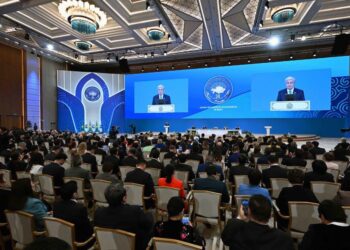Comment by the Russian Ministry of Foreign Affairs on the U.S. Report on Adherence to and Compliance with Arms Control, Nonproliferation, and Disarmament Agreements and Commitments (ACNPD) (to be added to the comment by the Russian Ministry of Foreign Affairs of May 5, 2019)
The Foreign Ministry has taken note of the detailed Report on Adherence to and Compliance with ACNPD Commitments by the U.S. Department of State. We note the following.
The United States has no legal, political or moral right to assess other countries’ compliance with ACNPD commitments they have undertaken under bilateral or multilateral agreements and treaties. Every international agreement in this field has its own elaborate verification and compliance mechanisms. In some cases, specialized international organizations have been established for this purpose. The aspiration of the U.S. to blatantly assign this function solely to itself is groundless and cannot be used as a pretext for conveying any views or conclusions.
We consider these attempts by the U.S. as a banal will to please its own self-esteem and put itself above all others. Such arrogance is subversive. It is a reflection of a deep internal self-identity crisis and definitely is not compatible with the status of a responsible nuclear power, especially as it claims to be a “leader” in ACNPD.
There is another side to this situation. Every page of the Report reflects the United States’ desire to cover up its own violations of obligations under the fundamental international legal instruments in the field of ACNPD, as well as to shift the responsibility to others and avoid criticism. This is what the extended section on the INF Treaty looks like, which is rather a failed attempt to defend itself for the collapse of one of the most important achievements in this area.
Furthermore, the longstanding practice of using ACNPD issues to deal with “undesirable” states and governments applied by the Americans is also evident. Are they really that good, according to Washington, at complying with ACNPD?
On the US withdrawal from the Joint Comprehensive Plan of Action on reconciliation around the Iranian nuclear programme (JCPOA)
The US has withdrawn from the JCPOA in violation of its obligations under the JCPOA and the UNSCR 2231. The Report draws a veil over the fact that the “nuclear deal” continues to enjoy support of the international community as effective and viable instrument for maintaining confidence in Iran’s nuclear programme.
In either case: accusations casted by the authors against Iran that it is breaching JCPOA commitments and does not cooperate with the IAEA turn to fail. Conversely under various pretexts they push forward the idea that Iran allegedly preserved documentation, infrastructure and personnel necessary for resuming military nuclear activities in case such political decision is taken.
The US policy on Iran can not digest that the IAEA Safeguards Agreement and the Additional Protocol are the main elements that guarantee in a long run the possibility to immediately detect any attempts by Tehran to switch its nuclear material from peaceful uses to military purposes and ensure the absence of undeclared nuclear material in Iran. Section on Iran remains silent in this respect. Although in other sections of the Report the authors are quite laudatory with regard to these verification activity mechanisms. Even overly laudatory which prompts a reminder that the Additional Protocol to the Safeguards Agreement is voluntary.
U.S. Withdrawal from the INF Treaty
We note with deep regret and concern that instead of seeking ways to maintain the INF Treaty, the U.S. has shown a worrying perseverance in achieving exactly the opposite goals and, by impeding all opportunities to bring the situation on a constructive track, on August 2, 2019, the U.S. completed the procedure of withdrawal from the Treaty initiated by it, and as a result, this instrument ceased to have effect.
Thus, Washington’s efforts resulted in the collapse of another international agreement, which was crucial for ensuring strategic stability and building regional and global security. The U.S. withdrawal from the INF Treaty has dealt another great blow to the arms control system, which took decades to build. Far-reaching negative consequences for international security in several key regions of the world seem almost inevitable.
Detailed assessments of the provocative actions by the U.S. regarding the long-term non-compliance with the INF Treaty, deliberate escalation of the crisis around the Treaty, as well as contrived pretexts to break it with an emphasis on unsubstantiated accusations against Russia, were provided in the Comment by Information and Press Department of the Russian Ministry of Foreign Affairs of May 5, 2019, following the publication of the initial short version of the Report on compliance with commitments in the field of ACNPD prepared by the U.S. Department of State, as well as during the briefing on this topic at the level of Deputy Minister of Foreign Affairs of the Russian Federation on August 5, 2019.
In light of developments, it is important to note that just two weeks after the collapse of the Treaty, the Pentagon carried out a test flight of a ground-launched “Tomahawk” cruise missile with a range formerly prohibited by the Treaty for the respective classes of missile weapons. An Mk-41 launcher was also used herewith. As the missile strike system included a ground-launched cruise missile with a range between 500 and 5,500 km, the U.S. tested the exact combination of missile and launcher, which was the subject of the main Russia’s claim regarding the compliance with the Treaty by the American side. This proves not only the validity of our long-standing concerns, which the U.S. has persistently ignored, but also the fact that Washington planned to withdraw from the INF Treaty well in advance and has long been engaged in the production of prohibited weapons under the Treaty.
In this regard, as well as taking into account the statements made by the Pentagon leadership on the desire to put medium- and shorter-range ground-based missiles at service of the U.S. Army, Russia will have to further analyze the level of threats to national security and strategic stability, including those arising from the U.S. complexes “Aegis Ashore” with Mk-41 launchers deployed in Europe and planned for deployment in the Asia-Pacific region.
However, Russia remains open to an equal and constructive dialogue with the U.S. to ensure predictability and strengthen international security.
We urge Washington to refrain from actions in the missile sphere that may destabilize the situation and from steps giving rise to a multilateral arms race, as well as to commit itself not to deploy these types of missile weapons in the same way as Russia did earlier by declaring a respective moratorium.
START Treaty
The U.S. Report once again states “full compliance” with its New START Treaty obligations. We still have no grounds to agree with this. The issue of Washington’s unilateral illegitimate withdrawal of hundreds of strategic offensive weapons from the accountability under the New START Treaty remains unsettled. We would like to remind the essence of this issue.
Russia and the United States were to have reduced the aggregate numbers of their strategic offensive arms to levels set in the Treaty’s Article II by February 5, 2018, and to exceed them thereafter. Russia had completely fulfilled its obligation that was confirmed by Washington. However, we cannot confirm that the United States has attained the levels set in the Treaty. The aggregate number of 800 for deployed and non‑deployed heavy bombers and launchers for strategic missiles, that were declared by the U.S., in fact is significantly exceeded. Washington has groundlessly and illegitimately removed 56 SLBM launchers and 41 heavy bombers B-52H from accountability under the New START Treaty. These weapons were declared “converted” as to be allegedly rendered them incapable of employing nuclear weapons. The Russian Side has not been provided with the opportunity to verify and confirm or refute the results of the “conversion” carried out by the Americans, as expressly stipulated by paragraph 3, Section I, Part III of Protocol to the New START Treaty.
Besides, the U.S. does not include in the accountability under the Treaty of four silo launchers designed for training, and attempts to justify its actions by claiming that these are “training silos,” a category not envisaged by the Treaty.
This problem created by Washington undermines obviously the Treaty’s viability and directly affects prospects for its extension. The search for ways to resolve this issue has failed to overcome the challenge to date. We will continue to ensure that the U.S. does not seek to create unilateral advantages for itself and fully complies with all New START Treaty provisions, that in fact, after Washington’s dismantling of the INF Treaty, remains the last international treaty to limit nuclear and missile capabilities of Russia and the U.S., as well as to make activities in this area predictable and mutually verifiable.
U.S. violations of obligations under the NPT
One more time the U.S. shows itself as a state that does not violate the NPT. We, again, have to draw attention to the fact that this is not the case.
The U.S. blatantly violates Article I of the NPT by involving non-nuclear NATO member states in the so-called “nuclear sharing”. It is widely known that such NATO practice includes elements of nuclear planning and developing practical skills in handling U.S. non-strategic nuclear weapons deployed in the territories of non-nuclear-weapon alliance member states, with the direct involvement of representatives of these countries, which is a violation of Article II of the NPT. The report is silent about the fact that we make it public on a regular basis, while at the very beginning of the document the authors assure that they will honestly state and refute all compliance claims put against them.
We urge the U.S. and its allies to cease violations of this key international Treaty and to ensure the return of American nuclear weapons to U.S. national territory, as well as to eliminate all infrastructure for swift deployment of these weapons on the territory of other NATO member countries. Any exercise involving the use of nuclear weapons with the participation of non-nuclear-weapon states should be completely abandoned.
Plutonium Management and Disposition Agreement (PMDA)
Grounds for suspension of the PMDA by Russia are given in Decree of the President of the Russian Federation No. 511 of 03.10.2016.
The main issue is the U.S. interference in Russia’s internal affairs and the build-up of NATO’s military infrastructure near Russia’s borders. In addition, we have reason to believe that the U.S. itself violated the 2010 Protocol to this Agreement.
We consider these grounds to be sufficient enough in the context of the Vienna Convention on the Law of Treaties.
Treaty on the Limitation of Underground Nuclear Weapon Tests
The United States’ allegations of alleged nuclear tests are false. The Russian Federation did not carry out any nuclear tests during the specified period (1995-2018).
Moratoriums on nuclear testing interpreted under U.S. “zero-yield” standard
The U.S. is one of the states responsible for the fact that the Comprehensive Nuclear-Test-Ban Treaty (CTBT) has not yet entered into force. We see no reason to hold a substantive discussion on the allegations of non-compliance with the moratorium on nuclear testing made by such a state or to refute them.
At the same time, we would like to emphasize three points.
First. Russia has never committed to complying with any U.S. nuclear testing standards.
Second. While telling other countries what “standards” they should adhere to, the Americans are hypocritically silent about their long-term “experiments” at the Nevada nuclear test site.
Third. We consider such allegations to be a clumsy attempt to justify in the international and domestic public eye the fact that for more than two decades since the Treaty’s opening for signature, the United States has taken no practical steps towards its ratification and ultimately refused to do so. Moreover, there is a reason to believe that accusations against others relate to Washington’s plans to withdraw its signature from the Treaty and resume full-scale nuclear testing.
Biological and Toxin Weapons Convention
The U.S once again accused Russia of violating the provisions of the Biological and Toxin Weapons Convention (BTWC) on the basis of speculation about the alleged relationship between Soviet biological programs and Russia’s research in microbiology. We emphasize that Russia’s activities in the medical and biological field are purely peaceful and fully consistent with our obligations under the BTWC.
In so doing, Washington is trying to distract the attention of the international community from its own questionable activities in this sensitive sphere. The Pentagon’s military and biological activity in various regions of the world, including in the post-Soviet areas right next to Russia’s borders, is a matter of concern. We have repeatedly drawn attention to the activities of the so-called R. Lugar Center for Public Health Research in Georgia, where the U.S. military are deployed on a permanent basis. It conducts research of which the U.S., for obvious reasons, does not provide any information within the framework of BTWC confidence-building measures.
In particular, this involves U.S. research into the development of an unmanned aerial vehicle designed to disseminate infected insects in the air as a means of delivering particularly dangerous infectious agents, various types of ammunition for small arms and light weapons with capsules containing biological formulations to infect humans, as well as experiments with plague bacteria capable of generating biofilms against all kinds of existing antibiotics.
The U.S. position regarding the legally binding protocol to the BTWC with an effective verification mechanism seems highly illogical. Formally advocating the strengthening of the Convention and traditionally presenting verification as a guarantee of the effectiveness of any arms control agreement, Washington has been blocking attempts to resume work on such a protocol since 2001.
We call on our American colleagues to comply with its BTWC commitments in a responsible manner, not in words but by taking practical steps to strengthen the regime of this important disarmament mechanism for international security.
Issues related to U.S. compliance with the CWC and OPCW politicization
In the light of the seriousness of the allegations of violations of the Chemical Weapons Convention (CWC) against us, the U.S., as a party to this international treaty, should have appealed to the Russian Federation to resolve possible contentious issues in bilateral consultations in accordance with its provisions.
The American side has chosen a completely different path of “megaphone diplomacy”. It should be noted that in the context of the London-inspired Skripals’ case against Russia, neither the management of the British Porton Down Laboratory nor OPCW specialists could confirm that the substances found in Salisbury and Amesbury belonged to a particular country. At the same time, we know from open sources that research on nerve agents was conducted in the United States since the 1980s, including compounds referred to in the West under the invented pretext as “Novichok”. Similar R&D activities were also carried out in the UK and in about two dozen other European NATO member and partner countries.
The OPCW has confirmed that the Russian Federation, in accordance with the provisions of the CWC, declared all its chemical weapons stockpiles and destroyed them under strict international control in 2017.
The statements about the research and the intention to use “incapacitants” are especially cynical given that the American side continues to maintain many reservations to both the CWC and the 1925 Geneva Protocol for the Prohibition of the Use in War of Asphyxiating, Poisonous or Other Gases, and of Bacteriological Methods of Warfare. These reservations imply, inter alia, retaliatory use of incapacitating chemical agents. Furthermore, existing Executive Order No. 11850, issued by the US President on 8 April 1975 even allows under certain circumstances the use of riot control agents for military purposes, which is strictly prohibited by the CWC.
Washington’s fictitious “concerns” about Syria with regard to Russia’s alleged assistance to Syrians in the use of chlorine in Douma and the “destruction of evidence” do not endure any criticism. Numerous independent experts from around the world, including from the U.S., Russian Defense Ministry specialists who visited the site of the incident, and even some members of the OPCW’s Syria Chemical Weapons Fact-Finding Mission (FFM) have repeatedly stated (and provided convincing evidence) that the incident was a gross provocation staged by The White Helmets, a pseudo‑humanitarian NGO controlled by the U.S. and British intelligence services.
Contrary to the U.S. statements, the Russian military police in Syria have never interfered with the investigation. On the contrary, it ensured the safety of OPCW experts working in Douma. This was highly appreciated by the leadership of the OPCW Technical Secretariat and reflected in the final report of the FFM. Therefore, Washington by making such statements has once again publicly questioned the competence of the OPCW Technical Secretariat. However, in April 2018, the United States and its allies launched an airstrike against Syria in violation of the provisions of the UN Charter, thus preventing the timely arrival of OPCW experts at the site of this chemical incident.
The Report by the Department of State notes the meaningful role of the U.S. in the establishment, at the initiative of France, of a pseudo non-proliferation International Partnership Against Impunity for Use of Chemical Weapons. This is understandable. The real purpose of this “special interest club” is not to discover the truth, but rather to “designate” those responsible for bypassing the UNSC. It is not surprising that already during the first meeting of the Partnership, the U.S. and France high-ranking representatives accused Syria of using chemical weapons, and Russia – of the “patronage” of Damascus.
Among its “achievements”, the U.S. mentions a key role in convening in June 2018 at the British initiative a special session of the Conference of the States Parties to the OPCW (CSP) under the pretext of the far-fetched Skripals’ case. During that CSP session an unlawful decision was taken to grant the OPCW, which is technical by its nature, a function to “identify the perpetrators” of the use of chemical weapons (the so-called “attribution”). At the same time, the fact that this decision is completely inconsistent with the CWC and interferes with the exclusive prerogatives of the UNSC is entirely neglected. Thus, many States parties to the CWC do not accept the decision, as they are well aware of the geopolitical intentions behind this initiative to remove the legitimate Syrian government from power under any pretext.
Military-political realities and the CFE Treaty
As the authors of the Department of State’s Report reiterate Russia’s decision to suspend participation in the Treaty on Conventional Armed Forces in Europe (CFE Treaty), presenting it as a “violation” of obligations under this Treaty, we would like to recall the following.
The U.S. and its allies have repeatedly circumvented the CFE Treaty restrictive provisions by expanding NATO. At the same time, they evaded, in every possible way, the renewal of the conventional arms control regime in Europe (CACE) proposed by Russia to meet the new military and political realities on the continent. The most visible proof of this is their refusal to ratify the Agreement on Adaptation of the CFE Treaty.
Only after Russia suspended the CFE Treaty, did the U.S. and its allies start talking about “the need to decide the future of the CACE”. However, their attempts to use the dialogue on this issue as leverage over Russia ultimately led to its freezing.
While in words they express a commitment to “preserving, strengthening and modernizing conventional arms control in Europe”, the U.S. and NATO are in fact focusing their efforts on Russia’s deterrence and further changing the balance of forces in Europe in their favor, including in the immediate vicinity of Russian borders. The U.S. attempts to interpret “with flexibility” the provisions of the Russia-NATO Founding Act on “substantial combat forces”, along with the build-up of heavy weapons and military equipment at NATO’s forward-based units and storage facilities in Europe, are de facto a dangerous balancing act on the verge of violating the provisions of this basic document.
In view of all these circumstances, there is no point to revert to implementation of the hopelessly outdated CFE Treaty.
As for the prospects for elaborating the new CACE regime based on the principles of equal and indivisible security, balanced rights and obligations of the parties, they should be considered in the context of NATO’s abandoning the policy of military ”deterrence” of Russia in Europe and normalization of relations with the Russian Federation, including in military cooperation.
Treaty on Open Skies
This is not the first time that the American side has made a set of overused allegations against Russia allegedly violating the Treaty on Open Skies (OST). We have repeatedly provided comprehensive answers to these allegations both at the Open Skies Consultative Commission (OSCC) and in comments regarding previous similar reports by the Department of State.
Limitation of the maximum flight distance over the Kaliningrad region. We would like to recall once again that this limit was introduced in accordance with the OST provisions and OSCC Decision No. 3/04. The existing procedure (established in accordance with the participating State’s right to designate additional airfields and to establish maximum flight distance (para. 1(c)) does not increase the number of flights required for the opportunity to observe the entire territory of Russia (para. 1 (a)), and ensures a higher level of efficiency of observation of the territory of the Kaliningrad region in comparison with the rest of the territory of Russia and the territories of other States Parties, including neighboring countries (Poland, Lithuania, Latvia and Estonia).
Restrictions on the OST flights near the borders with the independent states of Abkhazia and South Ossetia. These restrictions were introduced in accordance with the Treaty, which provides that observation flights should be carried out not closer than ten kilometers from the border with an adjacent State that is not a State Party.
In order to preserve the Treaty and break the deadlock, we removed the restrictions on flights within a 10-kilometer zone along Russian borders in the Caucasus in April 2018. At the same time, we reserved the right to revert to this issue in the future and warned that our permission to conduct observation flights in these zones will be permanent only if Georgia faithfully fulfills its commitments to receive Russian missions.
So far, Tbilisi’s position has not changed. As a result, Russia had to refuse an observation flight within the 10-kilometer zones during the joint mission of Sweden, Germany and the United States over its territory in April this year.
Unfortunately, the State Department’s Report conceals again the issues of compliance with the OST by the United States itself.
First. In 2016, the U.S. did not ensure the safe arrival of the Russian An-30B observation aircraft at the point of entry/exit, refusing to provide the required number of intermediate airfields. To date, the situation has not changed. This constitutes a violation by the U.S. of the Treaty on Open Skies.
Second. In 2017, the night-time rest stops for crews of observation aircraft at the refueling airfields, Robins and Ellsworth, were canceled. This constitutes a violation of the rights of the observing Party to perform observation flights at the maximum established distance, taking into account the norms of the crew’s workload limits, which is the issue of flight safety.
Third. The U.S., in violation of the Treaty, established a maximum flight distance over the Hawaiian Islands from the Hickam refueling airfield. However, according to the OST, the maximum flight distance is established only from Open Skies airfields and is calculated by specific rules. The distance limit of 900 kilometers established by the U.S. contrary to the provisions of the OST does not comply with the Treaty in any case, since using a more precise calculation this distance must be at least 1,160 kilometers.
Fourth. The U.S. imposed restrictions on observation flights over the Aleutian Islands territory, according to which the aircraft of the observing side should always remain within the outer border of the adjoining zone, spanning 24 nautical miles from the coast. This restriction, which is not provided for by the Treaty, significantly reduces the efficiency of the observation flight.
Fifth. The U.S. imposes restrictions on the altitude of the observation aircraft during observation flights over its territory, which are not provided for by the OST and are contrary to ICAO (Chapter 16) recommending the allocation of safe airspace on a fixed or mobile basis for the flight of military aircraft.
Vienna Document 2011
We are also compelled to note that with regard to the assessment of compliance with commitments under the Vienna Document 2011 (VD11) on Confidence- and Security-Building Measures, the United States regularly accuse Russia of “selective implementation” and “the lack of transparency”.
The United States’ claims with regard to the Vienna Document 2011 are limited to noting some concerns that the U.S. has had since 2014 in connection with “Russia’s implementation of VD11, including with respect to Ukraine”.
First. By groundlessly accusing Russia of “arming and training separatists in eastern Ukraine and conducting combat operations together with them,” the United States and other NATO countries have seriously discredited the role of the VD11 as an instrument of objective monitoring of the military activities of OSCE participating States. In this regard, we stress once again that the Russian Federation is not a party to the internal conflict in Ukraine.
With regard to the recurring allegations of “occupation”, “annexation” of Crimea and deployment of troops “without the consent of the host country” in the context of the Vienna Document (as well as the CFE Treaty), the Сrimea’s reunification with Russia is the result of the freely expressed will of its multinational people, and the current status of the Republic of Crimea and the city of Sevastopol as constituent entities of the Russian Federation was finally determined and is not subject to discussion. Therefore, Russia is free to deploy troops and military equipment on its territory, and attempts to inspect the territory of Crimea as part of Ukraine are provocative and futile. At the same time, Russia is certainly ready to receive inspectors, observers and assessment teams in Crimea if it receives relevant requests under the Vienna Document.
By the way, Kiev itself has so far failed to fulfill its commitments under the Vienna Document with regard to the military activities of its forces in Donbass. It is telling that the Department of State’s Report does not say anything about this.
Second. As for the reproaches addressed to us concerning the failure to provide information on the military bases of the Armed Forces of the Russian Federation located in the territories of Abkhazia and South Ossetia, we note that these sovereign States are not OSCE participating States and, accordingly, do not fall within the area of confidence-building measures, as defined in the Vienna Document 2011. The American experts responsible for this part of the Report are certainly well aware of this. Of course, they also know that the aforementioned information is provided by Russia in accordance with another OSCE document, the Global Exchange of Military Information.
Third. As for the Russian major weapons and equipment systems mentioned in the Report, we note that the BRM-1K armored combat vehicle does not fall into any of the categories of such equipment reportable under the Vienna Document, and some types of our aircrafts have not yet been officially introduced into service (currently in the production or military testing phase).
This process depends on many factors. Once the time-consuming procedures are completed and a decision regarding the categorization of these items under the VD11 is made, all the provisions of the Vienna Document in this regard will be implemented.
Fourth. The lack of information on the 126th Coastal Defense Brigade and 14th Fighter Aviation Regiment is due to the fact that these units do not meet the definitions of “combat unit” and “air combat unit”, which are reportable in accordance with para. 10 of the VD.
Fifth. In 2018, as before, Russia voluntarily sent notifications to OSCE participating States, including the United States, detailing the parameters of the snap inspections conducted, as well as informed them about the largest military exercises below the thresholds specified in the Vienna Document (joint Russia-Belarus military exercise Zapad-2018).
As for the reference to the Russian media regarding the conduct of various types of exercises without proper notification or invitation of foreign observers, all such exercises do not exceed the thresholds for notifiable military activities. In this regard, no notifications or invitations to observers in accordance with the provisions of the Vienna Document 2011 are required.
——————————————–
Foreign Minister Sergey Lavrov’s speech at the 11th Conference on Facilitating the Entry into Force of the Comprehensive Nuclear-Test-Ban Treaty, New York, September 25, 2019
Esteemed Co-Chairs,
Ladies and gentlemen,
I am happy to welcome all those present in this hall. I hope the conference will fully meet the requirements stipulated in Article 14 of the Comprehensive Nuclear-Test-Ban Treaty and will let us approach our common goal – the treaty’s entry into force.
Regrettably, our conference was overshadowed by an outrageous incident linked with the failure of the US to fulfil its commitments on the timely issuance of visas for members of the delegations coming to work at the UN. Almost every member of the Russian delegation that was declared to take part in today’s conference failed to receive visas even though we complied with all the required procedures. Apparently, it is time to consider moving these conferences from New York to more stable venues where the host country treats its commitments responsibly.
Returning to the subject, I would like to welcome the signing of the treaty by Tuvalu and ratification by Zimbabwe and Thailand. With their accession, the number of countries that have signed and ratified the treaty has reached 184 and 168, respectively. Each new ratification is vital for the treaty – it makes its status closer to universal and draws attention to the liability of the remaining eight states on which its entry into force depends.
Regrettably, the situation around the treaty has seriously deteriorated since the holding of the previous conference in 2017. The US official refusal to ratify the treaty is the main destabilising event. Our American colleagues and some of their associates claim that this decision does not change anything in practical terms. Meanwhile, it has serious destructive consequences for the treaty and international security in general.
The US refusal to ratify the treaty deprives it of the prospects to become an operational international treaty by virtue of its entry into force terms. The propriety of all efforts on forming a treaty-related infrastructure including an international monitoring system is being put under a big question mark.
Instead of revising its negative decision on the treaty Washington is trying to a cast a shadow on other states by accusing them of failure to observe it. This is being done without any grounds. This has already become common. The Americans do not support their assertions with any specific arguments. A country that does not intend (as it officially declared) to ratify the treaty does not have a formal or moral right to even discuss the commitments of other states to it. It is simply unseemly to use dirty tricks to cover up one’s potential withdrawal from the treaty.
We are seriously concerned about the US general destructive line as regards well-established and effective mechanisms and agreements on arms control and non-proliferation. We have said this more than once. A continuation of this policy is fraught with chaos and anarchy as well as lack of predictability in the nuclear field. The CTBT treaty is one of the major instruments for limiting the spread of nuclear weapons and promoting non-proliferation and is designed to play a fundamental role in ensuring international security and stability. Paradoxically, it was the United States that initiated drafting the treaty at one time. This has likely been forgotten by now.
As we see it, other states, including those listed in Annex 2 to the treaty, share the US position. The US could become the driver of the treaty’s ratification, it could set an example for others to follow. In this context, we urge the US government to revise its irresponsible decision on the treaty and take all the necessary steps for its ratification without delay.
We are also addressing our appeal to the seven countries on which the treaty’s entry into force depends. We urge them to sign and/or ratify the treaty as soon as possible. Needless to say, each of these countries is liable for the destiny of this document.
We appreciate the activities of the Provisional Technical Secretariat of the CTBTO Preparatory Commission headed by our well-known colleague, Lassina Zerbo. We have always supported the secretariat’s efforts to promote the treaty in the international arena. We also support the secretariat’s line on steady and balanced parameters for all elements of the mechanism for verifying compliance with the treaty. That said, we emphasise that the full and effective functioning of this verification mechanism is only possible after the treaty’s entry into force. The treaty can never be fulfilled on a temporary basis.
Having ratified the treaty in 2000, Russia has been strictly implementing its commitments. For us, this is the only effectively verifiable international treaty on the comprehensive ban of nuclear tests. There is no alternative to this. It cannot have any alternative. Russian leaders have repeatedly reaffirmed this position on the treaty.
Since 1991 Russia has observed a moratorium on nuclear testing. We have not staged a single nuclear explosion during this period. We intend to continue observing this moratorium given that other nuclear states follow the same line. We believe that a voluntary moratorium on testing, no matter how important it may be, cannot compensate for the failure to resolve the main task – to ensure the treaty’s entry into force. The unilateral commitments by individual states cannot replace full-scale international legal commitments under this document, either.
Russia closely cooperates with the preparatory commission on creating the Russian segment of the international monitoring system. Russia has already put 28 of the envisioned 32 facilities into service. We intend to make more progress in this area.
Esteemed Co-Chairs,
I reaffirm that we accept the final declaration of the current conference, which was negotiated in Vienna, including the list of measures on facilitating the treaty’s entry into force. We will take an active part in the implementation of these measures.






